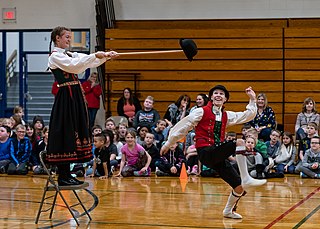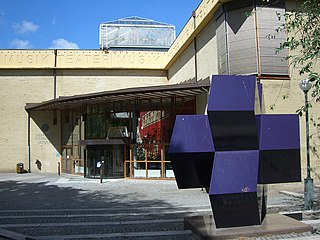Related Research Articles
The time signature is a convention in Western musical notation to specify how many of a particular note value are contained in each measure (bar), and in many cases how these note values are grouped into musical stresses (beats). The time signature is a notational device representing the meter, which is an auditory feature of the music.
Polka is a dance and genre of dance music originating in nineteenth-century Bohemia, now part of the Czech Republic. Though associated with Czech culture, polka is popular throughout Europe and the Americas.

A suite, in Western classical music and jazz, is an ordered set of instrumental or orchestral/concert band pieces. It originated in the late 14th century as a pairing of dance tunes and grew in scope to comprise up to five dances, sometimes with a prelude, by the early 17th century. The separate movements were often thematically and tonally linked. The term can also be used to refer to similar forms in other musical traditions, such as the Turkish fasıl and the Arab nuubaat.
The polska is a family of music and dance forms shared by the Nordic countries: called polsk in Denmark, polka or polska in Estonia, polska in Sweden and Finland, and by several different names in Norway. Norwegian variants include pols, rundom, springleik, and springar. The polska is almost always seen as a partner dance in 3
4-beat (help·info), although variants in 2
4 time, as well as in compound meters also exist.

The Music of Sweden shares roots with its neighboring countries in Scandinavia, as well as Eastern Europe, including polka, schottische, waltz, polska and mazurka. The Swedish fiddle and nyckelharpa are among the most common Swedish folk instruments. The instrumental genre is the biggest one in Sweden. In the 1960s, Swedish youth sparked a roots revival in Swedish folk culture. Many joined Spelmanslag and performed on mainstream radio and TV. They focused on instrumental polska music, with vocals and influences from other traditional genres becoming more prominent since the 1990s. By 1970, the "dansband" culture also began.

The music of Bulgaria refers to all forms of music associated with the country of Bulgaria, including classical, folk, popular music, and other forms.

Bulgarian folk dances are intimately related to the music of Bulgaria. This distinctive feature of Balkan folk music is the asymmetrical meter, built up around various combinations of 'quick' and 'slow' beats. The music, in Western musical notation, is often described using compound meter notation, where the notational meter accents, i.e., the heard beats, can be of different lengths, usually 1, 2, 3, or 4. Many Bulgarian dances are line dances, in which the dancers dance in a straight or curved line, holding hands.
Leventikos ; or Bufčansko, also known as Litós (Λιτός), Kucano, Nešo or Pusteno, is a dance of western Macedonia, mainly performed by ethnic Macedonians and Greeks in the town of Florina, Greece and in the Resen and Bitola regions in the neighbouring North Macedonia.

The Halling (hallingdansen) is a folk dance (bygdedans) traditionally performed in rural Norway, although versions of the halling can also be found in parts of Sweden. The dance is traditionally performed by young men at weddings and parties.

Sigvard Viggo "Sigge" Eklund is a Swedish novelist, TV producer and screenwriter. His books have been sold in 16 countries, and his podcast "Alex & Sigge's podcast" is the biggest in Sweden with over 500,000 listeners a week. He lives in Los Angeles with his wife, two sons, and daughter.
The hambo is a traditional dance that originated in Sweden in the late 19th and early 20th centuries. It is a couple dance in 3
4 time, danced to music played with a strong accent on the first beat and a tempo that varies from moderate to fast. The hambo is a dance with a fixed pattern and tunes almost always have a corresponding eight measure structure.

La Folía (Spanish), or Follies (English), also known as folies d'Espagne (French), La Follia (Italian), and Folia (Portuguese), is one of the oldest remembered European musical themes, or primary material, generally melodic, of a composition, on record. The theme exists in two versions, referred to as early and late folias, the earlier being faster.
Gammaldans (Swedish) or Gammeldans is a small set of Nordic dances that became broadly popular in the late 19th century. These were also the dances of the Nordic immigrant communities in the United States.
Snoa may refer to:

Nogalamycin is an anthracycline antibiotic produced by the soil bacteria Streptomyces nogalater. It has antitumor properties but it is also highly cardiotoxic. The less cardiotoxic semisynthetic analog menogaril was developed in the 1970s. Currently nogalamycin and menogaril are not used clinically.
Rimfrostjul is a Christmas music album by the Swedish singer Charlotte Perrelli released on 10 November 2008. The album includes the Malmö Symphony Orchestra and the Lund Student Singers.

The Academy of Music and Drama at the University of Gothenburg is a school for music, composition, opera singing, music staging, teaching of music and creative subjects in Gothenburg. It belongs to the Faculty of Fine, Applied and Performing Arts.
Det är 1988 och har precis börjat snöa is a 2005 Sigge Eklund novel.
References
- ↑ Gånglåt Snoa Dance Instructions, 1997 Skandia Music Foundation
- ↑ "Snoa (Klubba)". Archived from the original on 2011-10-08. Retrieved 2012-07-27.